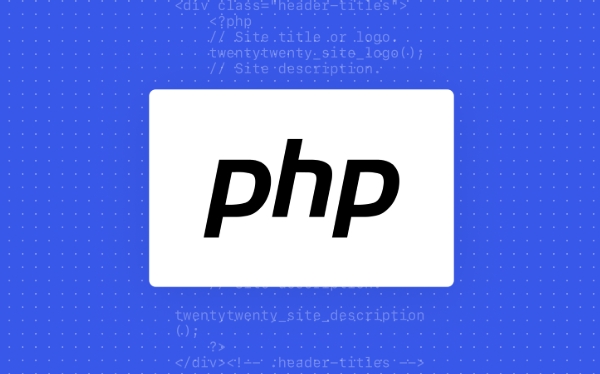To quickly build a stable PHP operating environment, you need to pay attention to the following steps: 1. Install the PHP interpreter, use XAMPP/WAMP for Windows, use Homebrew for macOS, and use apt for Linux; 2. Use a web server, use mod_php or Nginx for PHP-FPM for Apache; 3. Create info.php to test whether PHP is parsing normally; 4. Modify php.ini to enable display_errors, set error_reporting, adjust upload restrictions and time zones; 5. Use an optional Docker method to quickly build a standardized environment through docker-compose.yml. After each step is completed, the service should be restarted and the configuration should be verified to ensure the smooth progress of development and debugging.

Want to quickly build a PHP operating environment? Actually, it is not difficult, but to make it stable and convenient for debugging and development, there are still some details that need to be paid attention to.

Install the PHP interpreter
The first step is to install PHP itself. Different operating systems have different installation methods:

- Windows : You can use integration packages such as XAMPP or WAMP to install Apache, MySQL and PHP in one click.
- macOS : It is recommended to use Homebrew, just execute
brew install php. - Linux (Ubuntu/Debian) : Use apt to install, commands such as
sudo apt update && sudo apt install php.
After the installation is complete, enter php -v to verify whether it is successful. If you see the version number, it means that PHP is in place.
Run PHP with a web server
PHP is a scripting language that requires a web server to handle HTTP requests. There are two common combinations:

Apache mod_php
After installing Apache, enable themod_phpmodule, and then set the processing method of the.phpfile in the configuration file.Nginx PHP-FPM
Nginx does not support PHP natively like Apache, and requires PHP-FPM (FastCGI Process Manager) to handle requests. After installing Nginx and PHP-FPM, modify the site configuration file of Nginx and forward.phprequest to FPM for processing.
Regardless of the method, remember to test whether you can parse PHP files normally. For example, if you create an info.php with the content of <?php phpinfo(); ?> , visiting this page to see the detailed information of PHP means that there is no problem.
Configure PHP environment parameters
The default PHP configuration may not be suitable for development needs. You need to edit the php.ini file to adjust some key parameters:
-
display_errors = On: Turn on error display during development, which is convenient for debugging. -
error_reporting = E_ALL: Report all types of errors. -
upload_max_filesizeandpost_max_size: If you want to do file upload function, these two values ??may need to be increased. -
date.timezone: Set the time zone to avoid warnings.
After modification, restart the web server to make the configuration take effect. The paths of php.ini may be different under different systems. You can use php --ini to view the specific location.
Quickly build an environment with Docker (optional)
If you don't want to toss manually, Docker provides a way to quickly build a standardized PHP environment. You can write a simple docker-compose.yml file, define the mirror versions of PHP, Nginx, and MySQL, and then start the entire environment with one command.
The benefit of this approach is that the environment is clean and isolated, suitable for teamwork or project migration. For example:
version: '3'
services:
php:
image: php:8.2-fpm
Volumes:
- ./code:/var/www/html
nginx:
image: nginx:latest
Ports:
- "80:80"
Volumes:
- ./code:/var/www/html
- ./nginx.conf:/etc/nginx/nginx.conf Run docker-compose up and you can run directly.
Basically that's it. As long as you select the right tools and configure them in place, it is not complicated to build a PHP environment, but some details are easy to ignore, such as permission issues, service not restarted, etc. Just pay more attention.
The above is the detailed content of How to build a PHP runtime environment?. For more information, please follow other related articles on the PHP Chinese website!

Hot AI Tools

Undress AI Tool
Undress images for free

Undresser.AI Undress
AI-powered app for creating realistic nude photos

AI Clothes Remover
Online AI tool for removing clothes from photos.

Clothoff.io
AI clothes remover

Video Face Swap
Swap faces in any video effortlessly with our completely free AI face swap tool!

Hot Article

Hot Tools

Notepad++7.3.1
Easy-to-use and free code editor

SublimeText3 Chinese version
Chinese version, very easy to use

Zend Studio 13.0.1
Powerful PHP integrated development environment

Dreamweaver CS6
Visual web development tools

SublimeText3 Mac version
God-level code editing software (SublimeText3)

Hot Topics
 How do I implement authentication and authorization in PHP?
Jun 20, 2025 am 01:03 AM
How do I implement authentication and authorization in PHP?
Jun 20, 2025 am 01:03 AM
TosecurelyhandleauthenticationandauthorizationinPHP,followthesesteps:1.Alwayshashpasswordswithpassword_hash()andverifyusingpassword_verify(),usepreparedstatementstopreventSQLinjection,andstoreuserdatain$_SESSIONafterlogin.2.Implementrole-basedaccessc
 How can you handle file uploads securely in PHP?
Jun 19, 2025 am 01:05 AM
How can you handle file uploads securely in PHP?
Jun 19, 2025 am 01:05 AM
To safely handle file uploads in PHP, the core is to verify file types, rename files, and restrict permissions. 1. Use finfo_file() to check the real MIME type, and only specific types such as image/jpeg are allowed; 2. Use uniqid() to generate random file names and store them in non-Web root directory; 3. Limit file size through php.ini and HTML forms, and set directory permissions to 0755; 4. Use ClamAV to scan malware to enhance security. These steps effectively prevent security vulnerabilities and ensure that the file upload process is safe and reliable.
 What are the differences between == (loose comparison) and === (strict comparison) in PHP?
Jun 19, 2025 am 01:07 AM
What are the differences between == (loose comparison) and === (strict comparison) in PHP?
Jun 19, 2025 am 01:07 AM
In PHP, the main difference between == and == is the strictness of type checking. ==Type conversion will be performed before comparison, for example, 5=="5" returns true, and ===Request that the value and type are the same before true will be returned, for example, 5==="5" returns false. In usage scenarios, === is more secure and should be used first, and == is only used when type conversion is required.
 How do I perform arithmetic operations in PHP ( , -, *, /, %)?
Jun 19, 2025 pm 05:13 PM
How do I perform arithmetic operations in PHP ( , -, *, /, %)?
Jun 19, 2025 pm 05:13 PM
The methods of using basic mathematical operations in PHP are as follows: 1. Addition signs support integers and floating-point numbers, and can also be used for variables. String numbers will be automatically converted but not recommended to dependencies; 2. Subtraction signs use - signs, variables are the same, and type conversion is also applicable; 3. Multiplication signs use * signs, which are suitable for numbers and similar strings; 4. Division uses / signs, which need to avoid dividing by zero, and note that the result may be floating-point numbers; 5. Taking the modulus signs can be used to judge odd and even numbers, and when processing negative numbers, the remainder signs are consistent with the dividend. The key to using these operators correctly is to ensure that the data types are clear and the boundary situation is handled well.
 How can you interact with NoSQL databases (e.g., MongoDB, Redis) from PHP?
Jun 19, 2025 am 01:07 AM
How can you interact with NoSQL databases (e.g., MongoDB, Redis) from PHP?
Jun 19, 2025 am 01:07 AM
Yes, PHP can interact with NoSQL databases like MongoDB and Redis through specific extensions or libraries. First, use the MongoDBPHP driver (installed through PECL or Composer) to create client instances and operate databases and collections, supporting insertion, query, aggregation and other operations; second, use the Predis library or phpredis extension to connect to Redis, perform key-value settings and acquisitions, and recommend phpredis for high-performance scenarios, while Predis is convenient for rapid deployment; both are suitable for production environments and are well-documented.
 How do I stay up-to-date with the latest PHP developments and best practices?
Jun 23, 2025 am 12:56 AM
How do I stay up-to-date with the latest PHP developments and best practices?
Jun 23, 2025 am 12:56 AM
TostaycurrentwithPHPdevelopmentsandbestpractices,followkeynewssourceslikePHP.netandPHPWeekly,engagewithcommunitiesonforumsandconferences,keeptoolingupdatedandgraduallyadoptnewfeatures,andreadorcontributetoopensourceprojects.First,followreliablesource
 What is PHP, and why is it used for web development?
Jun 23, 2025 am 12:55 AM
What is PHP, and why is it used for web development?
Jun 23, 2025 am 12:55 AM
PHPbecamepopularforwebdevelopmentduetoitseaseoflearning,seamlessintegrationwithHTML,widespreadhostingsupport,andalargeecosystemincludingframeworkslikeLaravelandCMSplatformslikeWordPress.Itexcelsinhandlingformsubmissions,managingusersessions,interacti
 How to set PHP time zone?
Jun 25, 2025 am 01:00 AM
How to set PHP time zone?
Jun 25, 2025 am 01:00 AM
TosettherighttimezoneinPHP,usedate_default_timezone_set()functionatthestartofyourscriptwithavalididentifiersuchas'America/New_York'.1.Usedate_default_timezone_set()beforeanydate/timefunctions.2.Alternatively,configurethephp.inifilebysettingdate.timez






